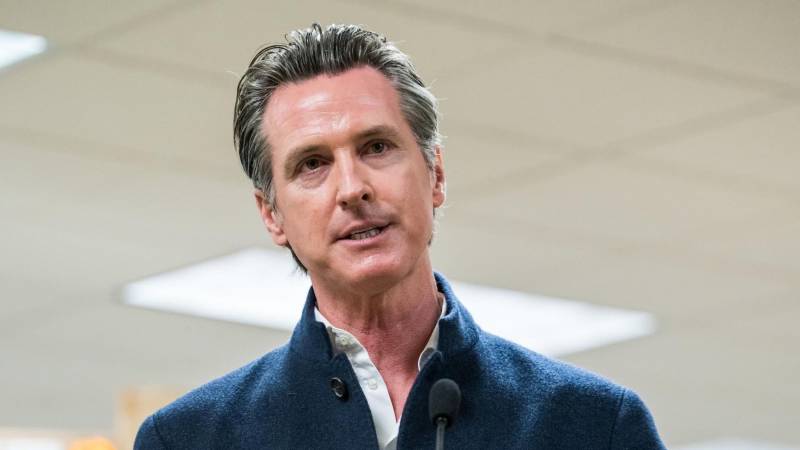Of the $2.7 billion in newly announced spending, about $1.2 billion would be for testing, including money to pay for extending the hours and capacity at state-run testing sites, while also sending millions of tests to local health departments, community clinics and schools.
Newsom wants the Democrat-dominated state Legislature to approve $1.4 billion of the money right away so he can spend it now instead of waiting for the start of the new fiscal year on July 1.
The state already has $1.7 billion to fight the pandemic, money the state Legislature approved last summer. But the Newsom administration says they need more money to continue spending at the same level.
The omicron variant spreads even more easily than other coronavirus strains, and has already become dominant in many countries. It also more easily infects those who have been vaccinated or had previously been infected by prior versions of the virus.
However, early studies show omicron is less likely to cause severe illness than the previous delta variant, and vaccination and a booster still offer strong protection from serious illness, hospitalization and death.
“From day one, California has taken swift and direct action to battle COVID-19 with policies that have saved tens of thousands of lives, but there’s more work to be done,” Newsom said in a news release.
Newsom's spending proposal is lumped into a few categories:
- Expanding testing site hours, distributing millions of antigen tests: $1.2 billion, which would also fund expansion of the state's ability to collect testing specimens to deliver to labs, which is the main bottleneck in speedy testing, officials said.
- Hospital staffing and health care systems: $614 million to help staffing shortages in hospitals and vaccination sites, among other patient care efforts.
- Vaccination efforts: $583 million to continue the "Vaccinate All 58" public education campaign, conducting community outreach door to door to get more people vaccinated, providing in-home vaccination and testing and providing free transportation throughout the state for vaccinations.
- Supporting contact tracing: $110 million, which would support what the governor's office called "increased public health and humanitarian efforts" at the Mexico border, including vaccinations, testing and quarantine services.
- Other state operations: $200 million would go toward staffing and IT support at the California Department of Public Health, Office of Emergency Services, and Emergency Medical Services Authority.
It’s unclear whether lawmakers would agree to spend the money early. Last month, Assembly Budget Committee Chair Phil Ting, a Democrat from San Francisco, said he did not think there was any need to rush to approve new spending. But at the time, Ting said things could change.
One thing that has changed since last month is that more people are testing positive for the virus. Over the past seven days, 21.7% of those tested for the virus have tested positive. That’s the highest rate ever for California.
Hospitalizations are on the rise, too.
On Friday, state hospitals admitted almost 2,800 people for COVID-19 treatment. Statewide, more than 10,000 people are hospitalized for COVID. There are 52,000 people hospitalized in general statewide, the governor’s office said, just shy of the winter hospitalization peak last year when 53,000 were hospitalized statewide.
With more people testing positive, Newsom is asking the state Legislature for a new law requiring companies to give workers more paid time off if they get sick. Last year, California had a law that required companies with 26 employees or more to give their workers up to an additional 80 hours of paid sick leave for things like having coronavirus symptoms, scheduling a vaccine or caring for a child who is doing school at home.
That law expired in September and state lawmakers did not extend it. Now, Newsom wants to bring some form of it back. It’s unclear what he’s asking for, however. A news release from his office called for “new legislation to implement supplemental paid sick leave policies given the current situation being driven by the Omicron variant to better protect our frontline workers.” It did not provide more details.
Statewide shortages have led to people paying out of pocket to access COVID tests.
Shane Hirschman, a 36-year-old from San Clemente, said he ordered a mail-in test kit from the Orange County health agency last week but never received one. When he started feeling sick this week, he said he couldn’t find an at-home kit in stores and testing appointments at nearby pharmacies were booked. He wound up paying nearly $100 for a rapid test to confirm he didn’t have the variant.
“They’ve had a year and a half to sort this out and it shouldn’t be like this,” he said. “I don’t feel like I can pay 100 bucks every day.”
In Los Angeles County, where a quarter of the state’s nearly 40 million people live, overwhelming demand prompted a temporary halt to a program that allowed people to test at home and mail back their sample. Public Health Director Barbara Ferrer said she hopes the testing crunch will ease in coming days. In the meantime, she urged restraint.
“Please don’t decide that because you didn’t get tested, you don’t have COVID and you don’t have to stay home if you’ve got symptoms,” she said. “We do ask while we’re trying to increase testing capacity and make it much easier for everyone who [needs] to test to get a test that you please stay home while you’re symptomatic.”
